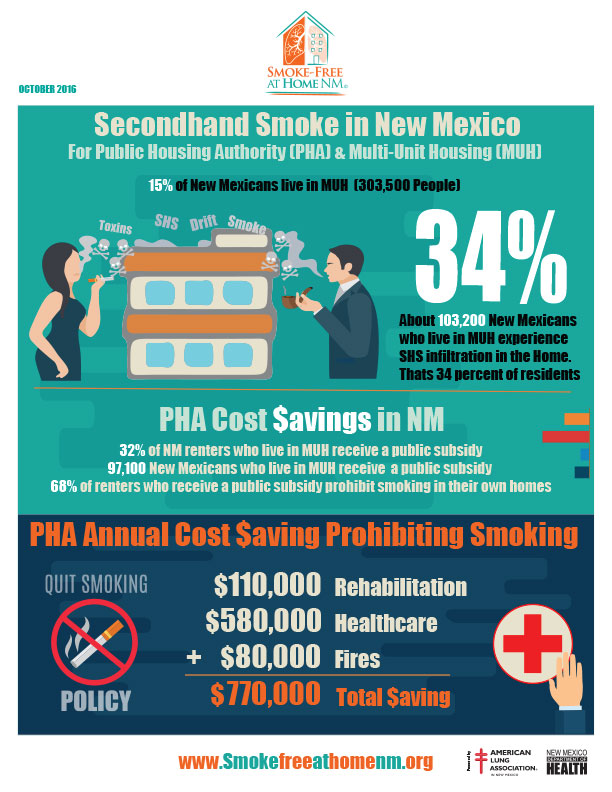Property Owners and Managers
Reasons To Go Smoke Free
What We Do For You
The Apartment Association of New Mexico (AANM), in partnership with the New Mexico Department of Health, will assist you in converting part or all of your multi-unit housing property into a smoke-free environment through our Smoke-Free at Home initiative.
We will provide technical support and assistance during the contemplation, research, and implementation phases of the process. We will offer additional support in the following ways:
- Education
- Manager and staff training
- Implementation
- Presentations
- On-site resident events
- Resident education
- Our signature “Thinking About Quitting” workshops
- Free Marketing on our Smoke-Free Map and Social Media “shout-outs”
Market Demand for Smoke-Free Living
Smoke-free properties are an attractive choice to many potential residents. Research from across the nation shows that more renters favor no-smoking policies where they live, and view them as a desirable amenity.1 Studies in different markets show a significant preference to smoke-free housing; as many as 70% say they prefer the policy, including 38% of people who currently smoke.3
Implementation of a smoke-free policy does not have a negative impact on tenant retention. Many properties experience a decrease in turnover or vacancy rates once a smoke-free policy is adopted. In fact, the majority of property owners who have implemented a smoke-free policy say they plan to keep their policies in place.2 By choosing to make your multi-unit housing property smoke-free, you are creating market appeal to a much broader audience here in New Mexico.
Reduce Turnover Costs
Units that have been smoked in are considerably more expensive to turn over for the next resident than nonsmoking units, and smoking units also tend to remain on the market longer.12 The costs related to cleaning and renovation are up to 75% lower in smoke-free properties.5 Units that housed smoking tenants incur additional expenses to clean, repaint walls and replace carpets, flooring, countertops, drapes, and fixtures damaged by cigarette burns or smoke exposure.13 Research shows that it is impossible to prevent smoke from infiltrating between apartments.9 One cannot escape the impact of neighboring units which contain cigarette smoke. The average cost for sealing a unit is about $700, yet this does not eliminate the problem.10 There is no safe amount of secondhand smoke; just being around it for a short time can cause harm. Children, pregnant women, older people, and people with heart or breathing problems are especially vulnerable.
Adopting smoke-free multi-unit housing policies can save property managers and owners hundreds and even thousands of dollars in building maintenance and turnover costs.12 Insurance companies often provide premium discounts to properties that implement smoke-free policies.
Lower Fire Risks and Related Insurance Costs
Smoking-related fires are the leading cause of fire deaths, and account for 17 percent of fire deaths in residential buildings and $303 million in property loss each year.14 There are 1,000 smoking-related fires in the United States every year resulting in between 700 and 900 deaths.6,7 Smoke-free policies reduce fire risks for residents, owners, and property managers. In some states, multi-unit property managers/owners, and condominium associations with smoke-free policies are eligible for discounts on fire, life, and property insurance.13
Financial Incentives
Some states offer financial incentives to real estate developers that adopt smoke-free housing policies. In California, for example, 38 out of 74 public housing authorities have received tax credits for making their units smoke-free. Additionally, the Low-Income Housing Tax Credit program is being used by cities and states including California, Maine, Minnesota and New Hampshire to encourage developers to include smoke-free policies in new building projects. 11 for New Mexico, the Mortgage Finance Authority’s Low-Income Housing Tax Credit program incentivizes the implementation of a smoke-free policy on both new or rehabilitated properties. For more information go to http://www.housingnm.org.
Legal Compliance
Many property owners and managers are unaware that smoke-free policies are legal and enforceable. The U.S. Department of Housing and Urban Development (HUD) supports property owners who include smoking restrictions in their leases for federally-subsidized housing. Recently, a law was passed by HUD that requires all PHAs to have a smoke-free policy in place by June 30, 2018.15 Being a smoker is not a protected status under civil rights laws.
Get Your Properties Listed on Our Smoke-Free Property Map!
Tools & Resources
Additional Resources
Websites
Spanish Resources
References
- Smoke-Free Housing New York (2010) “Steps to Smoke-Free Housing NY”
- Wilder Research (2009) “Perceptions of Secondhand Tobacco Smoke Among Minnesota Area Renters”
- Smoke-Free Oregon, smokefreeoregon.com
- NM Department of Health (2012) “Tobacco Use Prevention and Control Fact Sheet”
- Association for Nonsmokers-Minnesota (2009) “An Apartment Manager’s Guide to Adopting a Smoke-Free Building Policy”
- U.S. Fire Administration website. usfa.fema.gov
- U.S. Fire Administration (2005) “Residential Smoking Fires and Causalities”
- U.S. Fire Administration (2012) “Smoking-Related Fires in Residential Buildings (2008-2010)”
- Center for Energy and Environment (2004) “Reduction of Environmental Tobacco Smoke Transfer in Minnesota Multifamily Buildings Using Air Sealing and Ventilation Treatments”
- Center for Energy and Environment (2004) “Reduction of Environmental Tobacco Smoke Transfer in Minnesota Multifamily Buildings Using Air Sealing and Ventilation Treatments”
- Oregon Public Health Division, Health Promotion and Chronic Disease Prevention and Program Design and Evaluation Services. Evaluation of the Implementation of a Smoke-Free Policy in Subsidized Multi-Unit Housing. March 2009.
- Matt, G et al. When smokers move out and non-smokers move inL residential thirdhand smoke pollution and exposure. Tobacco Control 2011;20
- Tobacco Control Legal Consortium. Regulating Smoking in Multi-Unit Housing. 2011. http://publichealthlawcenter.org/sites/default/files/resources/tclc-guide-regulatingsmokingmultiunits-2011_0.pdf
- U.S. Department of Homeland Security, U.S. Fire Administration. Topical Related Fires in Residential Buildings. Topical Fire Report Series. 2010;11(4). http://www.usfa.dhs.gov/downloads/pdf/statistics/v11i4.pdf
- http://www.publichealthlawcenter.org/sites/default/files/resources/HUD-Final-Rule-Smoke-Free-Public-Housing-2016.pdf







